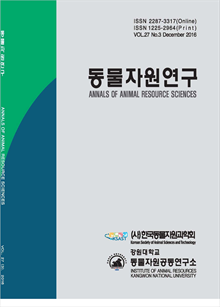간행물
동물자원연구 KCI 등재 Annals of Animal Resources Sciences

- 발행기관 강원대학교 동물자원공동연구소
- 자료유형 학술지
- 간기 계간
- ISSN 1225-2964 (Print)2287-3317 (Online)
- 수록기간 1990 ~ 2025
- 주제분류 농수해양 > 축산학 농수해양 분류의 다른 간행물
- 십진분류KDC 527DDC 636
권호리스트/논문검색
제36권 1호 (2025년 3월) 2건
1.
2025.03
구독 인증기관 무료, 개인회원 유료
A total of 225, 3 weeks old weaned pigs of the Landrace × Yorkshire × Duroc breeds with initial average body weight (BW) of 6.25±0.6 kg were randomly assigned to 3 different treatments based on their BW, with each having 5 replicates. Each replicate contained 15 pigs, resulting in 75 pigs per treatment group. The treatment included a basal diet (CON), CON + allicin and cinnamaldehyde mixture 500 ppm (ALI), CON + Bacillus-based probiotics 500 ppm (PRO) tested for 42 days in a 3-phase feeding program (0–14 as phase 1, days 15–28 as phase 2, and days 29–42 as phase 3). Result shows final BW (6.3%) and average daily gain (9.0%) in the overall phase were higher (p<0.05) in PRO compared with CON. At d 14, the level of Escherichia coli was lower (p<0.05) in ALI (12.0%) and PRO (13.2%) over CON. At days 28 (14.6%) and 42 (12.8%), the level of Escherichia coli was lower (p<0.05) in PRO compared with CON. The level of tumor necrosis factor-α was lower (p<0.05) in PRO over CON (15.0%). Superoxide dismutase (9.2%) and immunoglobulin A (19.4%) were higher (p<0.05) in PRO over CON. We concluded that dietary PRO at 500 ppm showed better performance in piglets by enhancing their growth performance and health.
4,500원
2.
2025.03
구독 인증기관 무료, 개인회원 유료
This study was analyze the causes of mortality to be used as basic data to fine ways to reduced the mortality rate of stocked Holstein calves. This study was used on 917 Holstein calves stocked at a fattening farm. Of the 917 stocked calves, the head of mortality was the 33 and a calf mortality rate was 3.6 %. A results of investigating the caused of mortality by disease, respiratory disease was 17 heads (51.52%), digestive disease was 12 heads (36.36%), other diseases was 3 heads (9.09%), and accidental death was 1 head (3.03%), major caused of calf mortality was resporatory and digestive disease acoounted for 87.9% of all. A head of mortality was 30 (90.91%) when the number of transports until stocking 2 times over compared with 1 time. Season has a significant effect on calf mortality, with calves in winter experiencing the highest (13 heads, 39.39%) mortality compared to other seasons. Comparing mortality rates based on stocking age, the highest (13 heads, 39.39%) mortality rate was observed in calves stocked at under 90 days of age, compared to other age groups. Comparing mortality rates based on the feeding age, the highest (18 heads, 54.54%) mortality rate was observed in calves fed for under 60 days, compared to those fed for over 60 days and other feeding age groups.
4,000원

